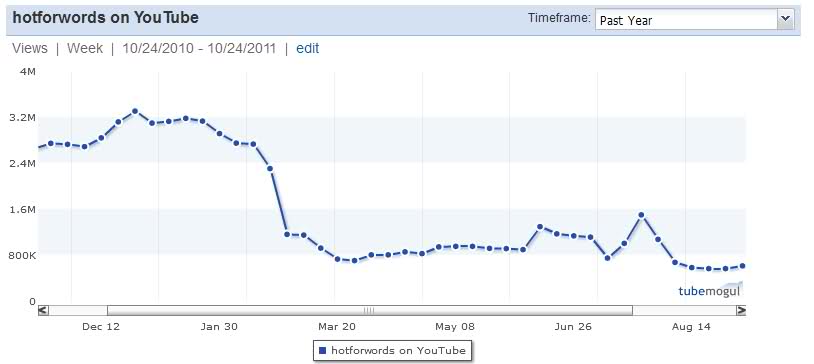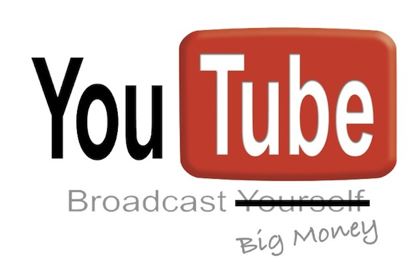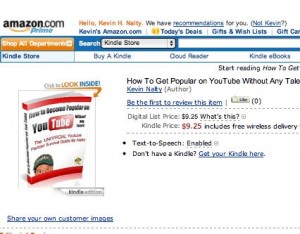You’ve seen the Ferris Bueller homage that promoted Honda during the Superbowl. Now watch Michael Broderick “then and now” as he delivers key lines in both the Superbowl ad and the film.
Be sure to check out all the advertisement’s “Easter egg” subtle nods to the film.
Tag Archives: YouTube
YouTube Statistics for 2012
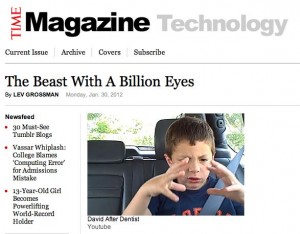 Time Magazine provided a rather exhaustive review of YouTube’s past, present and future. Check out the full article, titled “The Beast With a Billion Eyes” (a title, no doubt, with Shakespearean roots). Some highlights:
Time Magazine provided a rather exhaustive review of YouTube’s past, present and future. Check out the full article, titled “The Beast With a Billion Eyes” (a title, no doubt, with Shakespearean roots). Some highlights:
This is the first ever coverage of YouTube that failed to mention Shaycarl or Olgakay.
The piece cites the age-old quote that every minute that passes in real time, 60 hours of video are uploaded to YouTube, and then plays with the math (more video uploaded in past month than three big TV networks in the past 60 years).
YouTube gets 4,000,000,000 page views a day, which adds up to 1,000,000,000,000 a year.
The author creates the mock YouTube video title, “LOLOLOLOL this thing is amazeballs!!!!!!!”
YouTube recently enlarged the thumbnail images very slightly. “That change alone increased clicks to the Watch page by 2%,” said Margaret Gould Stewart, director of user experience.
On the efforts to boost channels (versus individual videos): Where there used to be two units of organization on YouTube–a single video and the 1 billion video collection–now there’s something in between.
YouTube has 800,000,000 users (about the same as Facebook) who watch 3,000,000,000 hours of video a month. But even one of the most-subscribed guys, RayWilliamJohnson, has 5.3 million subscribers. So that could suggest that the number of users who actually subscribe is in the low single digits.
Average viewing session remains a low 15 minutes (compared to hours of television binging).
Bunny Rounds Up Sheep (video)
A rabbit can scare sheep? Thanks to Weird Universe for sharing this delightful video of a little bunny rounding up sheep. Seems a German channel posted this just days ago…
YouTube for Entrepreneurs & Small Business
 Entrepreneurs and small businesses sometimes struggle with YouTube and online-video marketing. So I teamed with ReelSEO to write a guide called “Online Video 101: Small Business.” It’s free, and you won’t get a pesky sales call if you register and download it.
Entrepreneurs and small businesses sometimes struggle with YouTube and online-video marketing. So I teamed with ReelSEO to write a guide called “Online Video 101: Small Business.” It’s free, and you won’t get a pesky sales call if you register and download it.
Sorry the blog’s gone a bit grey lately, but I’ve been busy posting a video each day (every time you poop). Caught the virus from Trippy at his wedding. See ’em in this playlist called “Holiday Blitz.”
Sorry Weblebrities. Traditional Media Has Ad Value Density.
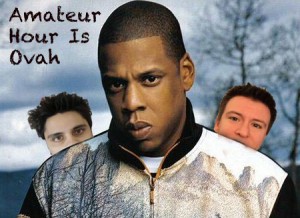
Weblebrities, also known as amateur “web stars,” are like the Gaddafi loyalists. They’re not done fighting, but odds favor Libya’s National Transitional Council headed by Abdurrahim el-Keib. (Sure he’s a former electrical engineering professor from the University of Alabama, but he’s the country’s interim prime minister).
The new regime of YouTube is The National Transitional Council of Professional Content, and it’s fortified by something more precious than allies, arms and cash. It has the online-video equivalent of nuclear weapons: “Ad Value Density.”
“Ad Value Density” is a phrase used by Michael Humphrey of Forbes when challenging some conclusions in Revision3’s Jim Louderback AdAge article (the piece gave some “watch outs” to old media entering new media land). Ad Value Density means the content can command a premium spend by advertisers, who are skittish about having their ads surround “consumer generated content,” and feel warm ‘n safe placing ads adjacent to content by real celebrities and network content.
Ad Value Density means, from a financial standpoint, a view’s not a view’s not a view. YouTube’s financial interest is to propagate content that meets the following criteria:
- It generates the most revenue: the high ad-value density for professional content means advertisers will pay a premium to surround that content… making each view on YouTube more profitable.
- The content will draw larger audiences who return frequently. If they follow the Golden Rule of web content: create constant content.
- It generates the most revenue.
Repetition by intent. Professional content will increasingly dominate YouTube, and that will draw larger and more profitable advertising spends. It makes good business sense for GoogleTube. As online-video begins to merge with television, Google wants to be The Distribution Platform. That means it needs content sought after by the unwashed masses who don’t yet use YouTube daily.
What’s not clear is how cable TV will respond. It turns out they’re the current platform, and have a strong-hold on most households with proprietary boxes and bundled channels that would be cost-prohibitive if sold “ala cart.”
In the meantime, it’s a continuous gentle fade for the weblebrities, except the fierce ones who morph with the medium… aligning with studios, securing cash from Google’s $100 million paid to professional content providers.
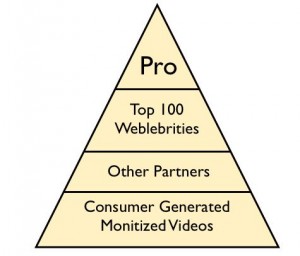
We’re seeing four tiers of content providers emerge, and YouTube placing a sharp emphasis on the top of the pyramid…
- Pro: Celebrities and professionally produced content (premium advertising due to “ad value density”)
- Top 100 Weblebrities: The leading YouTube stars (decent ads, and placement for a while)
- Partners: Declining emphasis as documented in my previous post (lower ad value)
- Consumer content with monetization: This is the “long tail,” and YouTube in past months has been working aggressively to monetize even tiny accounts (see proof). Here we’ll see mostly tiny CPMs and CPCs from some of the lesser known advertisers looking for cheap leads.
Nobody’s going to die quickly, but all signals suggest YouTube/Google is shifting its emphasis — from web originals and amateur “weblebrities” to celebrities and large content providers. Why? The latter has the potential of attracting people who aren’t using YouTube, and Google apparently believes it will have them coming back again (if they heed Louderback’s suggestion about creating content frequently). Simply put, higher on the pyramid the higher the “ad value density,” right?
Finally don’t underestimate the Gaddafi Weblebrity regime. Sxephil and others have already secured placement in the pro camp. The fierce creators may be able to segway their web fame into long-form content.
YouTube Changes: Gremlin Enters Pupil Stage

YouTube Changes: Phases, Winners, Losers & Gremlins
While preparing for an article for ReelSEO, I happened to be watching Gremlins (1984). I couldn’t help but see the parallels between YouTube changes and the cute and fuzzy Mogwai’s mutating into the entertaining but deadly Gremlins (pictured here). We’re about to see YouTube go “pro” in an extreme form, and that’s one of the biggest changes the video-sharing site has made in its history.
Don’t get me wrong. I like change. Even if it involves some interim puss-oozing pods during the “pupil” stage. And while I mourn for my RIP and decaying fellow independent creators (and my own channel), I am excited to see how YouTube/Google becomes a cable network despite the significant battles by studios, networks and serious content producers. It’s inevitable progress… even though I’ll miss the community (but they’re there somewhere, right?).
This post will be somewhat jumbled since my thoughts for the ReelSEO piece are still sorting themselves out. I would also value some input from people who’ve been watching YouTube’s transitions even more closely than me.
Some facts & phases of YouTube’s evolution (with considerable help from Urgo6667‘s ugly but robust SocialBlade data repository)
- Phase 1: YouTube in the 2009-2010 placed considerable emphasis on an exclusive and select pool of YouTube Partners. These independent content creators were rewarded with preferred placement throughout the site (driving views), advanced channel features, and premium monetization (sharing the income from higher yield advertisements from brands that feared consumer-generated content).
- Phase 2: Just as some governments reportedly destabilize other countries by introducing currency, the income caused new behaviors. As Archfiend laments in this video, the advertising income helped fuel desperate habits like faking thumbnail images, begging for comments and asking for 5 stars or thumbs up.
- Phase 3: YouTube, once the home of free speech and cat videos, began to become increasingly commercial. Once subtle ads soon blanketed the homepage. Optional prerolls became mandatory. The lines blurred between popular content and what was “featured” (based on advertising dollars or preferential content placement for select creators).
- Phase 4: Some prolific YouTube pioneers left the site jaded. These include Renetto, Pipistrello, and Comedian SeanBedlam (see his frustrated video posted in August announcing he’s quitting).
- Phase 5: As a great magician distracts you from his slight of hand, YouTube introduced the NextUp program. It gave $35K checks to a new crop of YouTube Partners to fuel their content.
- Phase 6: Now YouTube is going after cable and investing $100 million in professional content
But as 2011 progressed, YouTube changes resulted in views spread out in cryptic ways. Some YouTube channels have taken significant hits from these changes in which videos appear in powerful areas such as search results, “related videos” and “spotlights.”
I’ve shared my own sharp decline since September (in October I averaged 64% fewer views then 3 months ago), but this chart from once-popular HotForWords tells a typical story…
Fall of Pioneers… The decline of solo creators is not unlike the fate of Indie singers online… as viewers shifted to mainstream content that arrived late to the party. But check out some non-trivial examples:
- TheStation, which was launched by top YouTubers, went from more than 272,000 views October 2010 to under 110,000 in October 2011.
- Smosh, one of the most subscribed channels, is down 94% last month relative to 6 and 3 months ago. They were once the darlings of YouTube with frequent sponsors.
- SMPFilms, an early pioneer of YouTube meetups, is down 56% from 6 months ago… getting about 63,000 views currently (the drop is almost identical to the decline of Google’s channel on YouTube). MysteryGuitarMan (MGM) took a similar hit, and so did MediocreFilms.
- Some (but a minority) of the decline could be the creator’s diminished productivity. For instance I posted less frequently. But this seems unlikely given that MGM and Smosh are still rolling out new videos that get significant views.
- The decline is, perhaps, simply a return to normal. Most Partners saw a dramatic “artificial” lift in monthly views that were not dependent on their new content. In effect YouTube throttled creators and then stopped.
- More than 50% of my own views comes from related videos. Some of that might be based on an algorithm that attaches similar videos, and that’s presumably less likely to change. But YouTube may continue to “throttle” my videos as related videos, meaning I’ve got further room to drop. Here’s hoping the Wizards of Al don’t decide to beat me down again for this post.
- YouTube has not seen a decline in viewers, so the views are being spread out to the new “mini Partners” and other creators.
- Here are some of the fastest-growing Channels according to SocialBlade analysis: Vevo (which took a 1900% growth relative to 3 months ago), HollywoodTV, StanfordUniversity, and PlayStation with a remarkable 500K views a month.
- Stay tuned… working with Urgo I might publish a list of the biggest losers/gainers.
Thoughts? Observations? Insights? Bring ’em. And thanks mystery man (you know who you are).
YouTube Nears Transition to Television
In case you haven’t heard, the world’s largest online-video site is challenging television and cable with 100 channels funded by $100 million. The channels will be rolled out over the next year, starting in November. They will be available on the company’s website as well as all YouTube-enabled devices, including Apple’s devices.
Until then, YouTube has created a “sneak peek,” previewing what’s to come.
It’s a smart metamorphous from a commercial perspective. More mainstream content and increased distribution. And you can find 1-2 of the 100 channels that were spawned from independent creators (like sxephil). The rest of the independent creators will be moved to Revver.com to make room for the pros.
Invitation to Earn Revenue From Your YouTube Videos?
Did you get an e-mail lately with the subject, “Invitation to earn revenue from your YouTube videos”? What’s it mean?
You’ve been invited to “monetize” your videos. Since my sister hates that word, let’s put it this way. You’ll share in the income that YouTube makes from advertisers.
- This will amount to maybe $1 per 1,000 views. Could be pennies per 1,000 and it could be a couple bucks per thousand.
- The $ you get per views should continue to rise. Projections have been as high as 40% growth in 2012 to this report predicting 25% growth in online-video advertising in the next 12 months.
- You’ll need an Adsense account, which is how YouTube/Google pays publishers who run ads.
- Do it. No down side unless you abhor ads around your content.
- It’s not quite the same thing as being a YouTube “Partner” or “Creator,” which provides the channel with advanced branding (a logo on videos, and more flexibility on the channel page that few see). More importantly, advertisers are paying a premium for Partner/Creators and the other ads tend to command less revenue.
Still, my channels are excited. I’ll have to monetize them when I remember the passwords…
Any questions? Comment below or e-mail me at kevin (no space) nalty (a) g/mail
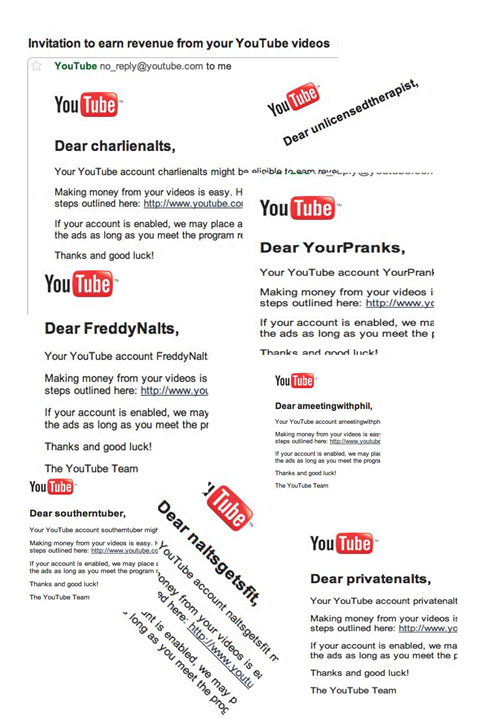
How To Get Views on YouTube (via Kindle)
So you want to know how to get views on YouTube. You want to grow a vibrant YouTube channel, go viral, and become the next Ray William Johnson. Do you cheat, or choose a more proven way?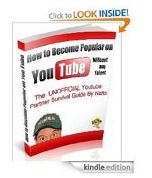
No Kindle lovers… you could read a great American classic on that sun-enabled iPad you call a Kindle. Or you could dive into some magazine article about the proliferation of germs on door handles. But here’s “How To Get Popular On YouTube Without Any Talent” right on the Kindle store. Is this a blatant promotion? Yes!
Oh it’s 34 pages long which is pretty beefy even though the image makes it look like a tomb.
YouTube to Become “Next-Generation Cable Provider”
YouTube, according to the Wall Street Journal and CNET, is looking to become the “next generation cable provider.” We’re seeing more and more shifts in the online-video medium, and YouTube appears to be making dramatic shifts away from its origin.
Reports CNet:
-

youtube 2012 Google has inked deals with InterActiveCorp’s Electus, News Corp., and “CSI” creator Anthony Zuiker to create content for its site. Celebrity skateboarder Tony Hawk has also reportedly signed a deal with Google.
- The company was investing $100 million in original content, and would create about 20 “premium channels” featuring 5 to 10 hours of original programming each week.
- But now that a recent study suggests online-video is giving cable a run for its money, things are changing.
Over the years, YouTube has relied on third-party content and has consistently said that it’s not in the original-content game. But according to the Journal’s sources, Google has designs on becoming a “next-generation cable provider” and has shifted its focus.
Will amateur and short-form video still matter? What do you think?

